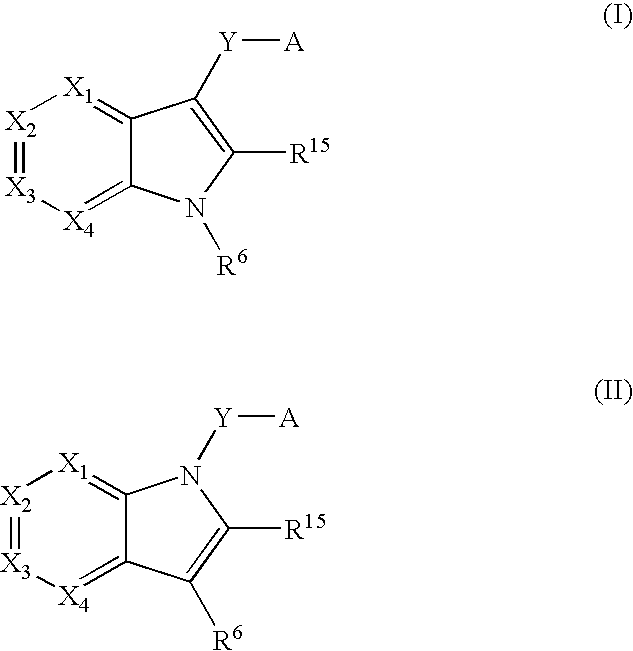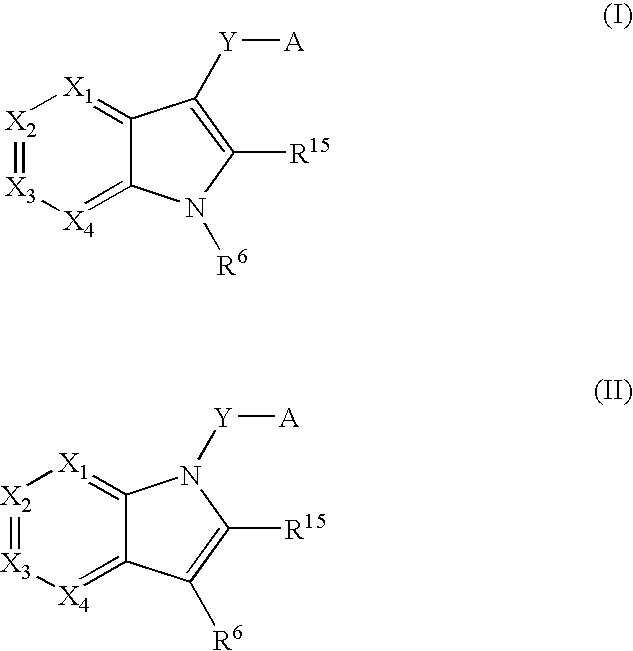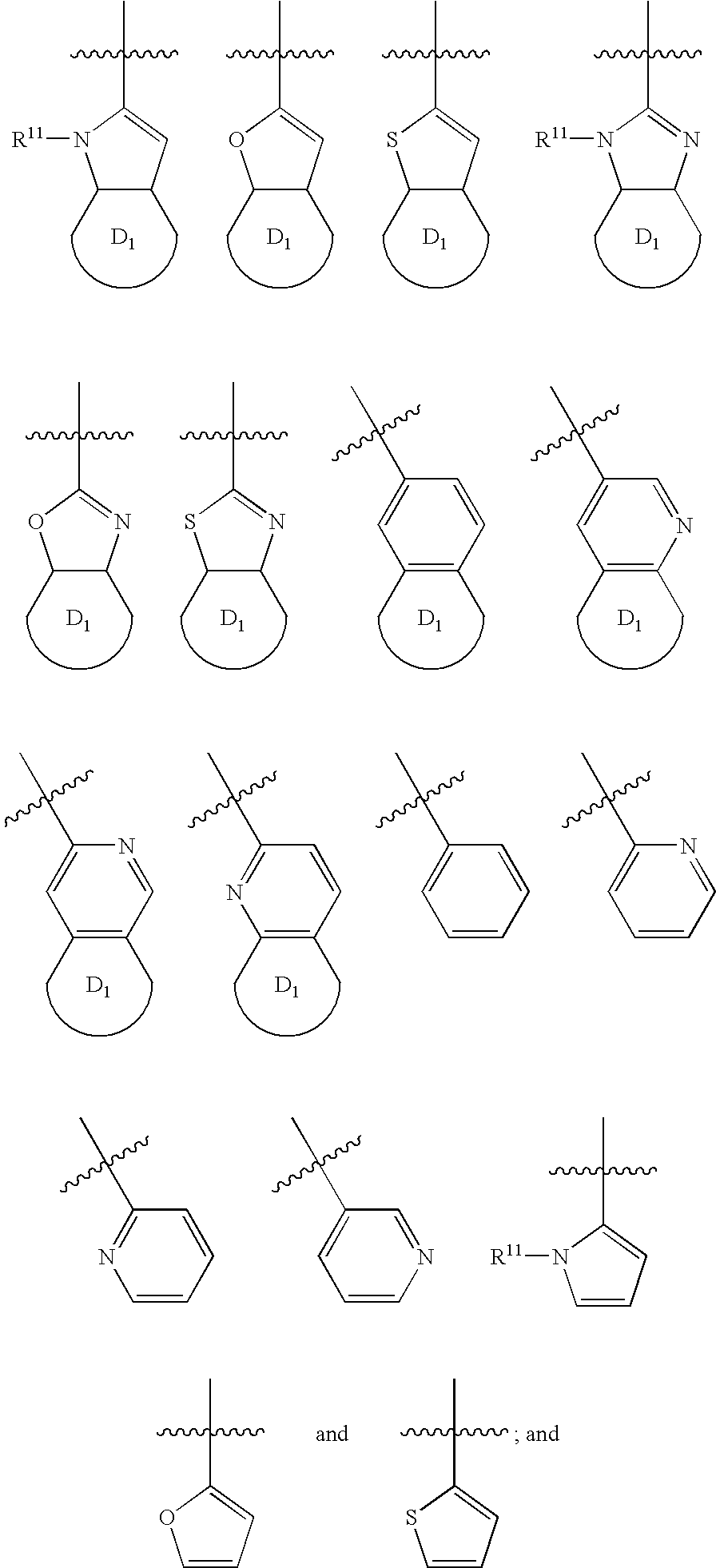Indole antagonists of p2y1 receptor useful in the treatment of thrombotic conditions
a technology of p2y1 receptor and antagonist, which is applied in the field of indole compounds, can solve the problems of in vivo study of antagonists without the necessary pharmacological properties
- Summary
- Abstract
- Description
- Claims
- Application Information
AI Technical Summary
Benefits of technology
Problems solved by technology
Method used
Image
Examples
example 1
3-(2-isopropylphenyl)-N-phenyl-1H-indole-1-carboxamide
[0307]
[0308]3-Bromo-1-(phenylsulfonyl)-1H-indole (7.45 g, 22.2 mmol), 2-isopropylbenzene boronic acid (4.00 g, 24.4 mmol), tetrakis(triphenylphosphine)palladium (0) (769 mg, 0.67 mmol) and sodium carbonate (7.05 g, 66.5 mmol) were combined in a round bottomed flask and placed under an argon atmosphere. Degassed solvent (3:1:1 toluene / ethanol / water) (100 mL) was added and the contents were heated to 80° C. for 14 h. Upon completion of the reaction, as determined by TLC, the phases were separated, the aqueous phase was extracted three times with 20 mL ethyl acetate and all the organic phases were combined, washed once with water (20 mL) and once with brine (20 mL). The organic phase was dried over Na2SO4, filtered, and the solvent was evaporated under reduced pressure to yield a dark residue which was purified by silica gel chromatography eluting with a gradient of ethyl acetate / hexanes to yield 3-(2-isopropylphenyl)-1-(phenylsulfo...
example 49
3-(2-tert-butylphenyl)-N-p-tolyl-1H-indole-1-carboxamide
[0311]
[0312]1-(Phenylsulfonyl)-1H-indol-3-ylboronic acid (150.9 mg, 0.501 mmol), 2-tert-butylphenyl trifluoromethanesulfonate (255 mg, 0.902 mmol) and tetrakis(triphenylphosphine)palladium (0) (58 mg, 0.050 mmol) are combined in a septa capped microwave vial and placed under an argon atmosphere. Degassed solutions of 2 M sodium carbonate (0.75 mL, 1.50 mmol) and of dioxane (2.5 mL) were introduced and the vial heated to 150° C. for 15 minutes in a microwave reactor. The cooled reaction mixture was diluted with water and ethyl acetate, the phases separated and the aqueous extracted twice more with ethyl acetate. The combined extracts were washed with water, brine, dried over sodium sulfate, filtered and evaporated. The residue was purified by silica gel chromatography eluting with a gradient of ethyl acetate and hexanes to give 3-(2-tert-butylphenyl)-1-(phenylsulfonyl)-1H-indole (175.8 mg, 92%) as a colorless gummy solid.
[0313]3...
example 50
1-(2-isopropylphenyl)-N-(4-(trifluoromethoxy)phenyl)-1H-indole-3-carboxamide
[0315]
[0316]To a screw capped vial was added methyl 1H-indole-3-carboxylate (17 mg, 0.1 mmol), 2-isopropylbenzene boronic acid (33 mg, 0.20 mmol), and activated 3 Å molecular sieves (100 mg). Anhydrous dichloromethane (1.0 mL), anhydrous pyridine (16 μL, 0.2 mmol) and anhydrous triethylamine (28 μL, 0.2 mmol) were added, the vial capped and the reaction was stirred under air for 15 min. Anhydrous copper(II) acetate was added, the vial capped, and the reaction was stirred overnight under air at 45° C. The reaction was quenched with 20 drops of methanolic ammonium hydroxide (concentrated aqueous ammonia and methanol 1:1), filtered with the aid of additional dichloromethane in order to remove the molecular sieves and the solution applied to a silica gel column for chromatography. Elution with a gradient of ethyl acetate and hexanes furnished methyl 1-(2-isopropylphenyl)-1H-indole-3-carboxylate (10 mg, 35%) as a...
PUM
| Property | Measurement | Unit |
|---|---|---|
| Time | aaaaa | aaaaa |
| Time | aaaaa | aaaaa |
| Time | aaaaa | aaaaa |
Abstract
Description
Claims
Application Information
 Login to View More
Login to View More - R&D
- Intellectual Property
- Life Sciences
- Materials
- Tech Scout
- Unparalleled Data Quality
- Higher Quality Content
- 60% Fewer Hallucinations
Browse by: Latest US Patents, China's latest patents, Technical Efficacy Thesaurus, Application Domain, Technology Topic, Popular Technical Reports.
© 2025 PatSnap. All rights reserved.Legal|Privacy policy|Modern Slavery Act Transparency Statement|Sitemap|About US| Contact US: help@patsnap.com



